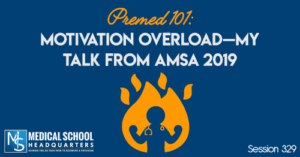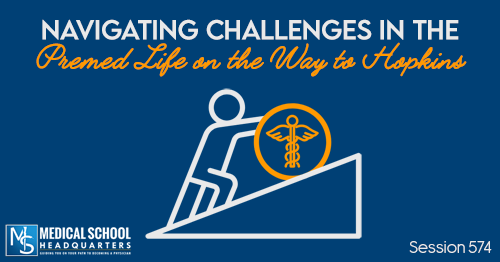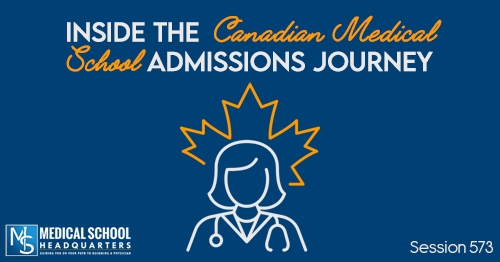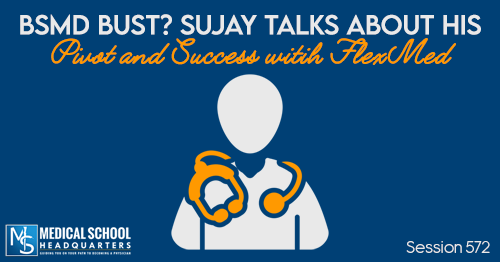Apple Podcasts | Google Podcasts

Session 329
I had the awesome privilege to talk at the 2019 AMSA Convention to an awesome group of premed students. I wanted to share the encouragement with all of you. In the talk, I also busted a bunch of premed myths and so much more!
Hopefully, this gives you the motivation to continue waking up everyday, happy to be a premed and motivated to continue on to medical school and beyond.
If you’re new to this, please visit all our other podcasts on the MedEd Media Network for more resources to help you along your journey towards becoming a physician. If you haven’t taken the MCAT yet, be sure to check out The MCAT Podcast and The MCAT CARS Podcast. If you’re looking for some motivation about different specialties out there, listen to Specialty Stories. If you’re a nontraditional student, visit The OldPreMeds Podcast.
By the way, Learn more about AMSA and reach out to them. Their main organization is for medical students but they also have premed chapters. If you don’t have one at your college, see what it takes to start one at your college. Stay tuned for Premed Fest AMSA which happens every year! Also, check out the annual AMSA Convention in April 2020 in DC. In June 2019, I will be in Toronto for a conference so if you’re in the Toronto area or interested in going there, I’m doing a meetup on the 9th.
[04:13] Some Common Myths About Going to Medical School
Myth #1: If you fail a class, then medical school is not right for you.
This is not true at all. You can fail a class and still get into medical school. You don’t have to be perfect to get accepted to medical school. I was going to have somebody on this podcast who has 16 F’s in her undergrad, 5 withdrawals who got into medical school this year.
Which medical school you go to doesn’t matter either. Getting into one school or five schools, there’s still that struggle. So if you’re going through this process and had a terrible semester or year and this is what you want to do, fix it, move forward, course-correct, and figure out how to improve the next semester, the next class, the next year. You may have to take a little more of extra time like take more classes after you graduate. But if that’s what you have to do then you have to do it.
In short, you don’t have to be perfect!
[08:45] Myth #2: You need to have a checklist to get into medical school.
You don’t have to do research to get into medical school. When you look at the stats, schools put out information showing 90% of students doing research and only 70% doing clinical experience. But that’s not the best data.
Instead, you have to prove to yourself that you want to be around sick people. Taking care of your grandma is fun and endearing, but taking care of someone else’s grandma when the family is yelling at you or mad at you is not going to be so much fun. What you need to do through this process is not check off all the boxes. Prove to yourself that this is what you want to do. And to do that, you need shadowing. You need to experience what a day in the life of a physician is.
[11:13] You Need to Shadow
If you’re a nurse or PA or NP, and you’re working with a physician all the time, you still have to shadow. Yes, you work with them in that one setting. But what are they doing when they’re leaving that setting? They’re on the phone or on the computer. They’re arguing with insurance companies. Are you going to enjoy doing that?
A Hopkins study looked at resident hours, specifically how much time residents spent with patients. And they actually only spend around 11% on direct patient care. Hence, shadowing will help you experience what the physicians are doing day in and day out. It’s not all glamorous or saving lives all day long. You’re not going to be thanked all the time. Patients can be annoyed by you or mad at you. They could resent you since they think it’s you causing health insurance prices to skyrocket. When in fact, the doctors are getting paid less, so we have to do more to get paid the same amount.
Being a physician is an amazing career. But you can’t go into this thinking that it is more glamorous than what it is. Too many physicians come out of training burnt out thinking it was going to be different than what it is. So you need to go out and shadow. Understand what a physician’s life is like and what you’re going to be doing day in and day out.
[14:20] Shadowing vs. Clinical Experience
Shadowing is different than clinical experience. Shadowing is a passive experience where you follow the physician around. You’re listening and observing, not interacting. On the other hand, with clinical experience, you need to be interacting with the patient. You have to be close enough to smell the patient. You have to interact with the patient. You have to be there, care for them, support them.
Moreover, being in the hospital isn’t necessarily a clinical experience. Just because you’re mopping the floor in the hospital is not clinical experience. If you’re ER volunteering and only stocking shelves or putting towels on the warmers, that’s not clinical experience. You need to be interacting with patients and their families. You need to understand what it’s like to have somebody relying on you for support.
[16:45] Nontraditional is the New Traditional
If you have any doubt in your mind that this is what you’re supposed to be doing, slow down and figure it out. You don’t have to go from high school to undergrad and start medical school right after.
Nontraditional is the new traditional. The majority of students are now taking gap years. They’re figuring out if this is what they want. They’re taking the time to get more experience. They still want more knowledge to see if this is what they’re supposed to be doing. So take that time.
[17:40] You Don’t Need Research and Research Doesn’t Have to Be Clinical
Again, you don’t have to do research. You can try it to see if you like it. You don’t even have to be a Biology major or microbiology major. Major in whatever you want – language, art, etc.
Some premed advisors tell people they can’t get into medical school since their white as they’re accepting less and less. Not true!
When I applied the first time, I didn’t get in. I made some phone calls and figured out why my application was weak. I reapplied and was ultimately accepted at New York Medical College. I didn’t do research but still became a physician. So it’s not going to hold you back.
Also, research isn’t only about sitting in a lab. You can do clinical research. Find a physician to shadow and ask if they’re doing any sort of clinical research where they’re studying their patient population. That’s research.
[22:05] You Don’t Have to Be Perfect
You don’t have to check the boxes or do everything you think you have to do. The admissions committees want you to be you. Enjoy who you are and everything you’re doing. Ultimately, you’re going to be one person in a class of 100-200. And you will add diversity to that class. They are building a class – a community of students. They’re not looking for a perfect 4.0 or 528 MCAT students. They’re looking for people who have diverse experiences.
For instance, if you’re a soccer coach and love it, keep on coaching soccer as coaches are leaders. They’re teachers. The experiences you’re getting from the activities you want to do and the passion that will come out in your extracurriculars, personal statement, and interviews will far exceed anything if you’re doing it just because you think you have to do it.
You can get into medical school without clinical experience or shadowing or research. However, you need to do some of them. You need to prove to yourself that this is what you want to do.
[25:55] You Don’t Need to Have the Best Scores
You don’t need the best GPA or MCAT scores but they need to be good enough so you can make it to the next step of the journey when you apply. Medical schools will tell you that they don’t screen up applications. While some don’t, the majority will do. Medical schools get 5,000 to 14,000 applications each year so to quickly sort and filter, they’ll drop students who are below a 3.0 GPA or 500 MCAT score for instance. They will set criteria so they can more easily manage the application process.
That student that had 16 F’s took classes. She fixed her application to get above certain thresholds so schools would take a look at her. This may take longer for you or cost more, but if this is what you want to do, then you have to figure it out.
[27:17] The Application Process: What Do You Need
Your primary applications open up in May every year to be accepted for the next year. If you want to start medical school in 2020, you have to apply this year in 2019. The things you need for medical school application are letters of recommendation from professors or physicians (not a patient). You need your MCAT score. You won’t need it when you apply but your application won’t be complete until your MCAT score is turned in.
You need a personal statement. Please check out The Premed Playbook: Guide to the Medical School Personal Statement. The personal statement is there to tell the admissions committee why you want to be a doctor and not how great of a doctor you think you’re going to be. And you need to understand that in your core.
You have to write extracurriculars and your experience descriptions. Write about all the things you’re doing – research, clinical experience, work, hobbies, etc. Your experiences need to paint a picture of who you are.
Everybody freaks out about the school list. There is no perfect list of schools. Every medical school is looking for something different. When you’re putting together your school list, ignore the numbers. But where do you want to go? You have to be reasonable and realistic in the process. Consider the geographic location, weather, class size, proximity to family and friends, curriculum type. Do some self-reflection to understand which school you really want. Applying to medical school is a lot about you and whether the schools fit you.
[32:50] Apply Early
There is a deadline but ignore it. In fact, set in your mind that the deadline is two months after the application opens. Applications open June 1st to submit for MD schools. Texas and DO schools, you may submit as soon as you’re ready to submit.
A majority of schools in this country are based on rolling admissions. The sooner your application is submitted, the sooner your secondary essays are complete or your MCAT score is complete and submitted to the schools, then the sooner your application is reviewed. The sooner you’ll be invited for an interview. And the sooner you get an acceptance.
Each day that passes, more students are being verified in the application system. Interview invites are being sent out and medical schools only have a limited number of days that they interview students and a limited number of people they can interview each day.
A certain NIH professor told students that applying to medical school is your first medical school test and it’s open book. You know everything that’s on the test. And if you’ve submitted your application in October, then you’failed your first medical school test. This just shows that you can’t prioritize your time or that you can’t organize, or you’re not just motivated enough to figure it out.
You can get in applying the last day but those students are amazing applicants though or have something that just stands out above everything else. TMDSAS released stats that around 85% of students who get interviews applied by July.
[36:55] The Waiting Game, Interview, and Acceptance
This is probably the worst part of the process. Be sure to prepare for the interview process early. Do mock interviews with your advisors. Check out The Premed Playbook: Guide to the Medical School Interview.
[40:20] Q & A Session
Q: How do you approach when asking for letters of recommendation?
A: First, ask who you’re going to get a letter from. When you go into a class, set expectations with your professor. Meet them early on, tell them hopefully you’re going to be able to build a relationship with them so you can eventually ask them for a letter of recommendation. Hopefully, the professor will set his expectations in return and tell you what they expect from you if you really want a good letter of recommendation from them. Again, ask first. Don’t delay asking, so you can perfect your resume, CV, personal statement, etc.
There are going to be professors that are going to ask a draft from you. See what they want. Others would say you write them a draft and they’ll just tweak it and sign it. This is technically against the rules. But a lot of professors do that.
Q: Is there anything outside the academics that you can do better?
A: Form study groups and help each other where one person is weak and another is strong. Help your classmates because this will not hurt your chances of getting into medical school. Focus on collaboration, not competition.
Q: Tips for writing a personal statement?
A: Talk about why do you want to be a doctor. Humans are drawn to stories so stories resonate the most in a personal statement. Show the reader what’s going on, don’t tell them what’s going on. Show the reader what it was like to be there for a patient. Most importantly, reflect on the experience in your personal statement. Tell them why it’s important for your journey. Show the reader why you want to do this. Reflect on your journey and help them understand why the experiences have solidified in your mind that this is what you want.
Q: What are the different curriculums? How do we know what different schools offer?
A: Most schools have websites that have their curriculum there. If you can’t find it, just call them or email them and ask. The traditional curriculum is like in undergrad and you learn it all separately. A systems-based curriculum is one where, for instance, you learn about the cardiovascular system in a “block.” And in that block, you learn anatomy, physiology, histology, pharmacology, etc – everything is integrated into the cardiovascular system so they’re all fit to make sense altogether.
Some schools will integrate problem-based learning in whatever system they have. This consist of small group settings where you’re given a clinical vignette. They will either create or buy from a source these long drawn-out clinical vignettes of a patient. As a team of students, you then need to figure out what to do and how to diagnose it or treat it, figure out the complications from the treatment, or what happens when you don’t diagnose it properly, etc. There’s usually a moderator, typically a physician, to help if you get stuck.
The flip classroom is when instead of going to a lecture, you get to learn the material at home and then use the classroom to interact and ask questions and build upon the knowledge you’re learning yourself.
Links:
The Premed Playbook: Guide to the Medical School Personal Statement











